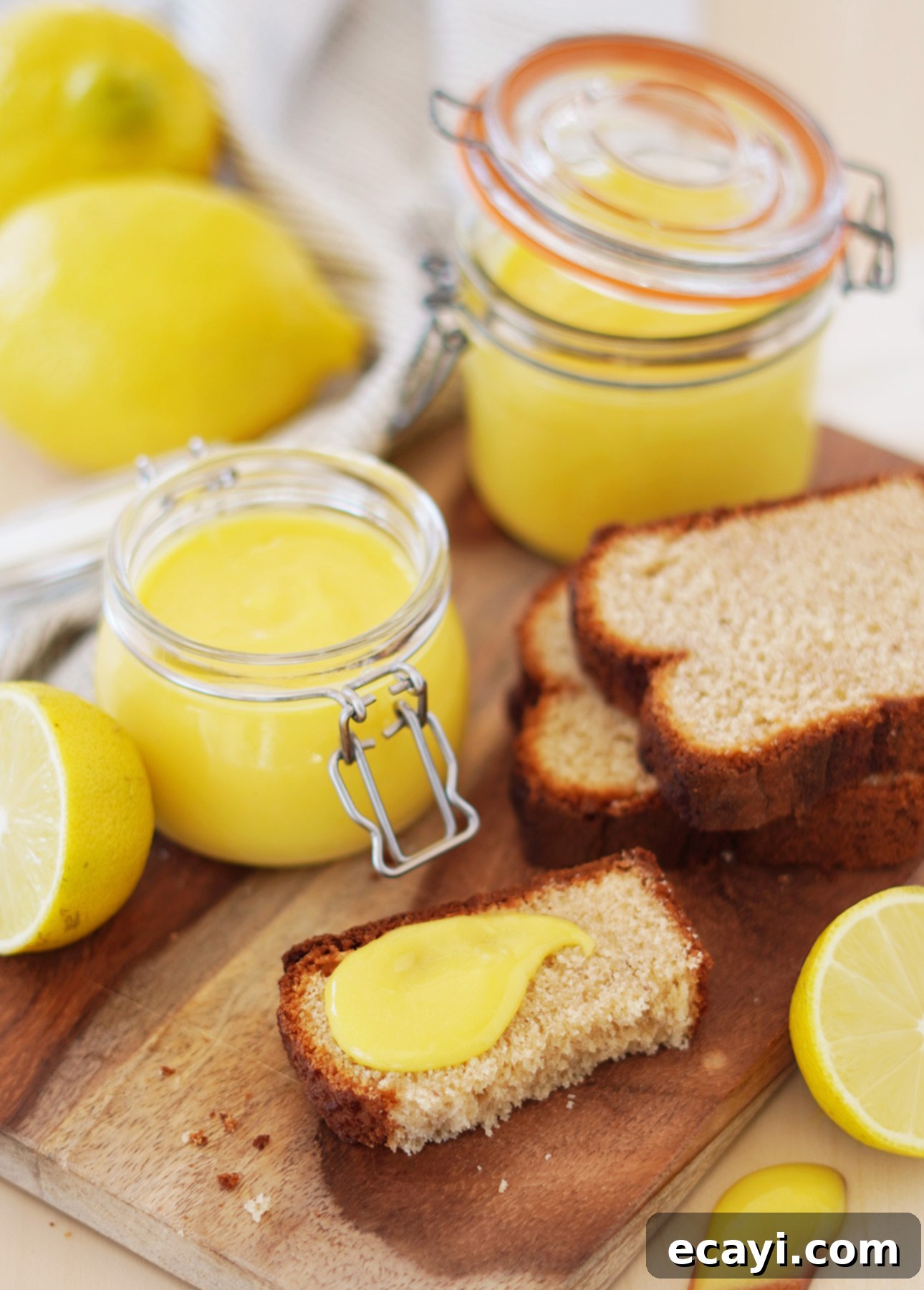Luscious No-Butter Lemon Curd: A Healthier, Brighter, and Incredibly Easy Recipe
Indulge in this exquisite no-butter lemon curd, a delightful spread that’s better for you yet retains all the rich, puckery zest of its traditional counterpart. Discover the fascinating history of lemon curd, master the simple steps to make it at home, and explore countless ways to savor this versatile treat from your breakfast table to elegant desserts!
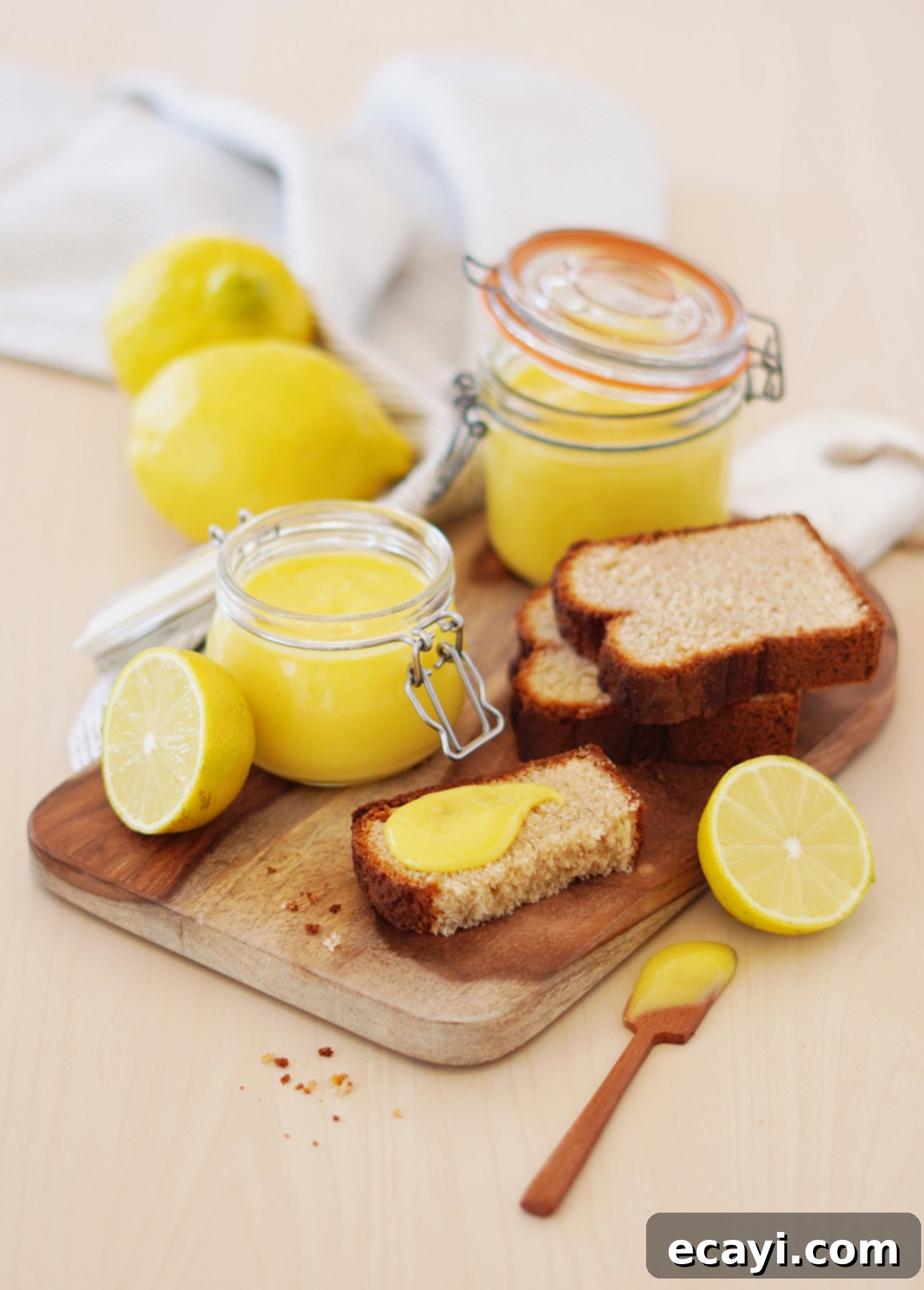
This post contains affiliate links. Full disclosure is at the bottom of the article.
Lemon curd stands out as one of the most beloved and vibrant citrus condiments. Its appeal is truly multifaceted: from its cheerful, sunny yellow hue to its invigorating, zesty, and perfectly puckery flavor, it brings a burst of brightness to any meal. What makes it even more remarkable is its incredible versatility, seamlessly transitioning from a simple breakfast spread to a sophisticated dessert component.
A Brief History of Lemon Curd: From English Tea Tables to Modern Kitchens
Lemon curd’s roots trace back to 19th-century England, where it emerged as a staple in traditional afternoon tea. Initially, “lemon cheese” or “lemon curd” was a simpler preparation, often made by curdling cream with lemon juice, which was then strained through cheesecloth to separate the solids from the whey. Over time, the recipe evolved. Butter, eggs, and sugar were introduced, transforming it into the rich, velvety, custard-like spread we adore today. This modern iteration quickly became a popular alternative to jams, frequently served alongside scones, fresh bread, and various cakes. Its delightful tang and smooth texture also made it an ideal filling for pastries and tarts, cementing its place in culinary history.
My Journey to a Butter-Free Lemon Curd
For many years, I adhered to traditional lemon curd recipes, appreciating their classic richness. However, a desire to create a version that was friendlier to my lactose-intolerant system prompted me to experiment. My goal was to eliminate the substantial amount of butter typically found in these recipes without compromising on flavor or texture. After countless trials and adjustments, I perfected a completely butter-less lemon curd, and to my surprise, I discovered I didn’t miss the traditional, butter-laden variety at all.
The feedback from everyone who tasted it was overwhelmingly positive; they adored its bright flavor and luxurious texture, completely oblivious to the absence of the extra calories from butter. This breakthrough meant I could enjoy my favorite citrus condiment more often and share it with others without dietary concerns. Since then, I’ve never looked back.
This no-butter lemon curd has become my absolute go-to recipe. The secret to achieving its sublime, silky consistency lies in the clever use of a small amount of cornstarch. This ingredient acts as a brilliant thickener, providing stability and a smooth mouthfeel that rivals butter. A touch of heavy cream is then added to contribute a subtle richness and to perfectly balance the vibrant, puckery taste – the very hallmark of this delightful condiment. The result is a lighter, yet equally indulgent, lemon curd that’s perfect for any occasion.
I genuinely believe you’ll become as enamored with this recipe as I am. I always keep a fresh jar of this no-butter lemon curd chilling in my fridge, ready to elevate anything and everything, from a simple breakfast to an elegant dessert. Its addictive quality is undeniable, and I’m confident you’ll find yourself reaching for it just as often!
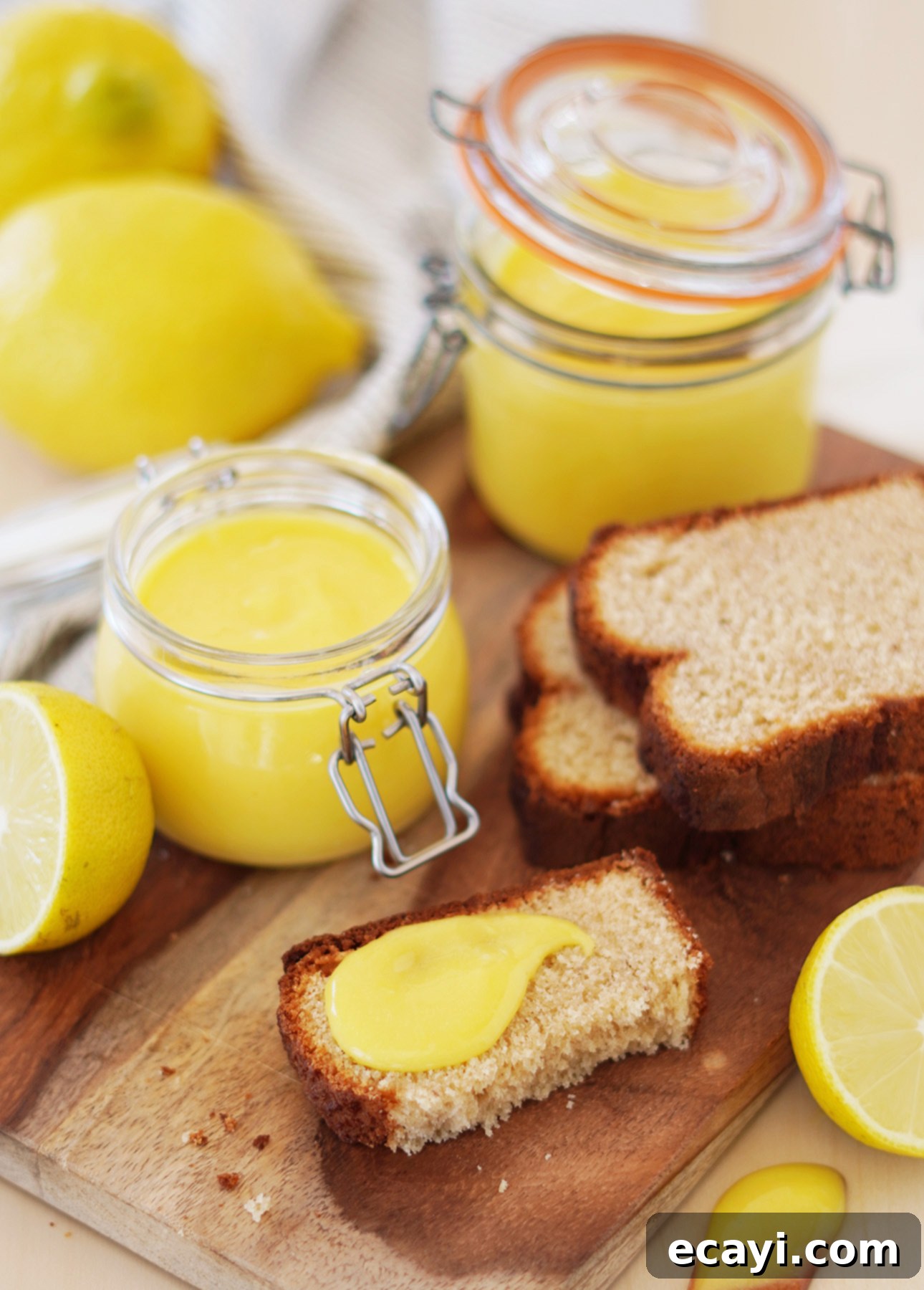
If you’re new to the wonderful world of lemon curd, or simply looking to refine your homemade skills, here’s a deeper dive into what makes this condiment so delightful, along with some essential tips to help you master it in your own kitchen.
Why Is It Called a “Curd”? Tracing the Culinary Evolution
The name “curd” itself offers a glimpse into the condiment’s historical origins. In 19th-century England, the term “curd” literally referred to the process where acidic lemon juice was mixed into cream, causing it to curdle. The resulting solids, or “curds,” were then carefully strained from the liquid whey, often through a fine cheesecloth, to create a thick, spreadable substance. This early version was quite different from what we typically enjoy today.
As culinary techniques advanced and preferences shifted, the recipe underwent a significant transformation. Butter, eggs, and sugar were gradually introduced, replacing the cream as the primary thickening and enriching agents. This evolution led to the rich, velvety spread that is now universally recognized as modern lemon curd. Today, lemon curd is essentially a type of custard, where a liquid (in this case, lemon juice) is thickened to a smooth consistency by the coagulation of egg proteins, a process that creates its signature texture and luxurious mouthfeel.
Key Ingredients for Traditional Lemon Curd vs. My No-Butter Version
Traditional lemon curd recipes are typically built upon a foundation of butter, egg yolks (or whole eggs), sugar, and, of course, fresh lemon juice and zest. In this classic preparation, butter serves a dual purpose: it acts as a thickening agent, contributing to the curd’s emulsified structure, and, crucially, it imparts a rich, luxurious mouthfeel and a deep, satisfying flavor. The generous amount of butter is what gives traditional curd its characteristic decadence.
However, in my innovative no-butter lemon curd recipe, I’ve successfully achieved the same desired velvety texture and rich flavor without a single gram of butter. This is accomplished through a clever combination of ingredients: a spoonful of cornstarch and a bit of heavy cream (or a dairy-free alternative). The cornstarch acts as a powerful, neutral-tasting thickener, ensuring the curd achieves that beautiful, spoonable consistency. The heavy cream then steps in to provide the essential richness and smooth mouthfeel that butter would normally offer, all while allowing me to completely omit butter from the equation. This substitution results in a lemon curd that is not only healthier and lighter but also incredibly flavorful, making it a fantastic “better-for-you” condiment without any compromise on taste or texture.
Fine-Tuning the Sweetness: Can You Add More Sugar to Lemon Curd?
Lemon curd is celebrated for its exquisite balance, delicately walking the fine line between vibrant acidity and just-sweet-enough indulgence. This careful equilibrium is precisely what gives it its characteristic bright and refreshing quality. However, the natural sweetness and acidity of lemons can vary significantly depending on the variety, ripeness, and even the season. While I personally adore the puckery zest that defines classic lemon curd, I understand that some palates might prefer a slightly mellower experience, enjoying the aromatic qualities of lemon without its full acidic punch.
If you find yourself desiring a touch more sweetness in this no-butter lemon curd recipe, you absolutely can adjust it. I recommend adding up to 2 tablespoons (approximately 24 grams) of granulated sugar. This modest addition is usually sufficient to round off the edges of the acidity without making the curd overly sweet, maintaining its essential lemon character.
Alternatively, if you’re specifically seeking a sweeter, less acidic citrus curd from the outset, consider using Meyer lemons. These unique citrus fruits are a hybrid of a lemon and a mandarin orange, resulting in a significantly sweeter and less tart flavor profile compared to regular Eureka or Lisbon lemons. Their delicate floral notes also add another layer of complexity. Another excellent approach is to swap a portion of the required lemon juice for juice from sweeter citrus fruits like oranges, mandarins, or clementines. This natural substitution will inherently sweeten the curd, reducing the need for additional granulated sugar and introducing a delightful complexity of flavor.
For more detailed guidance on balancing flavors with different citrus varieties, please refer to my comprehensive citrus fruit juice to sugar ratios provided below. This chart offers specific insights into crafting perfect curds with a range of citrus fruits, ensuring your homemade curd is always tailored to your taste preferences.

Storage Guidelines: How Long Can I Keep No-Butter Lemon Curd?
To maintain its optimal freshness and vibrant flavor, it’s best to store your no-butter lemon curd in an airtight jar in the refrigerator. When properly stored, it will remain delicious and perfectly safe to enjoy for up to 5 days. Be sure to use a clean, sterilized jar to maximize its shelf life.
The Freezing Dilemma: Can I Freeze No-Butter Lemon Curd?
It’s important to note that this particular no-butter lemon curd recipe is not suitable for freezing. The reason lies in its unique composition and the way it’s cooked – much like a delicate pastry cream stabilized primarily with cornstarch rather than butter. When frozen and then thawed, the texture of this curd undergoes an undesirable and irreversible change.
Unlike some butter-based curds that might fare better, this cornstarch-stabilized version will lose its rich, smooth, and silky consistency. The freezing and thawing process causes the fats (from the cream) and proteins (from the eggs and cream) to separate, resulting in a completely different, often unappetizingly grainy or watery texture. That luxurious mouthfeel you strive for in your pastries, tarts, and other delightful applications will unfortunately be gone. This textural breakdown is a permanent alteration that cannot be remedied once it occurs. Therefore, to preserve the quality and delightful consistency of your homemade no-butter lemon curd, please avoid freezing it! Enjoy it fresh within its refrigerated shelf life.
Exploring Other Citrus Flavors: Can I Use Different Citrus Fruits to Make Curd?
Absolutely, the world of citrus curds extends far beyond just lemons! You have the exciting option to use virtually any citrus fruit to create your own unique curd. This adaptability allows for a fantastic range of flavors, from sweet to intensely tart, catering to every preference.
- Clementines and Mandarins: These are among my favorite alternatives for curd making due to their incredibly aromatic quality and balanced sweetness. They yield a curd that is delightfully fragrant, often less acidic than lemon curd, and possesses a beautiful, soft orange hue.
- Oranges (Blood, Cara Cara, Navel): Using oranges will result in a much sweeter and milder curd compared to lemon. Oranges possess a natural sweetness that significantly tames the acidity, producing a condiment that is wonderfully flavorful but far less puckery. If you swap oranges for lemons, remember to adjust the sugar quantity accordingly (typically less sugar is needed).
- Limes: For those who truly revel in intense tartness, limes are an excellent choice. Lime curd offers a sharp, vibrant, and incredibly refreshing flavor profile, often with a slightly more floral aroma than lemon. It’s perfect for summer desserts and tropical-inspired dishes.
- Grapefruit: If you enjoy a bittersweet tang, grapefruit curd is a must-try. It provides a sophisticated complexity with its characteristic bitterness balancing out the citrusy tartness, creating a very grown-up and distinctive flavor.
- Yuzu: This Japanese citrus fruit offers a unique, highly aromatic flavor that is a cross between a lemon and a mandarin orange, with distinct floral notes. Yuzu curd is incredibly fragrant and exotic, providing a gourmet twist. Bottled yuzu juice makes this an accessible option even when fresh yuzu is hard to find.
You can also unleash your creativity by mixing citrus fruits. Imagine a harmonious curd crafted from lemons and clementines, blending the best of both worlds – the bright acidity of lemon with the sweet aroma of clementine. Don’t hesitate to experiment!
To help you navigate these exciting possibilities, please refer to my detailed list of fruit juice to sugar ratios below. This guide will ensure you achieve the perfect balance for your desired citrus curd, no matter which fruit you choose.
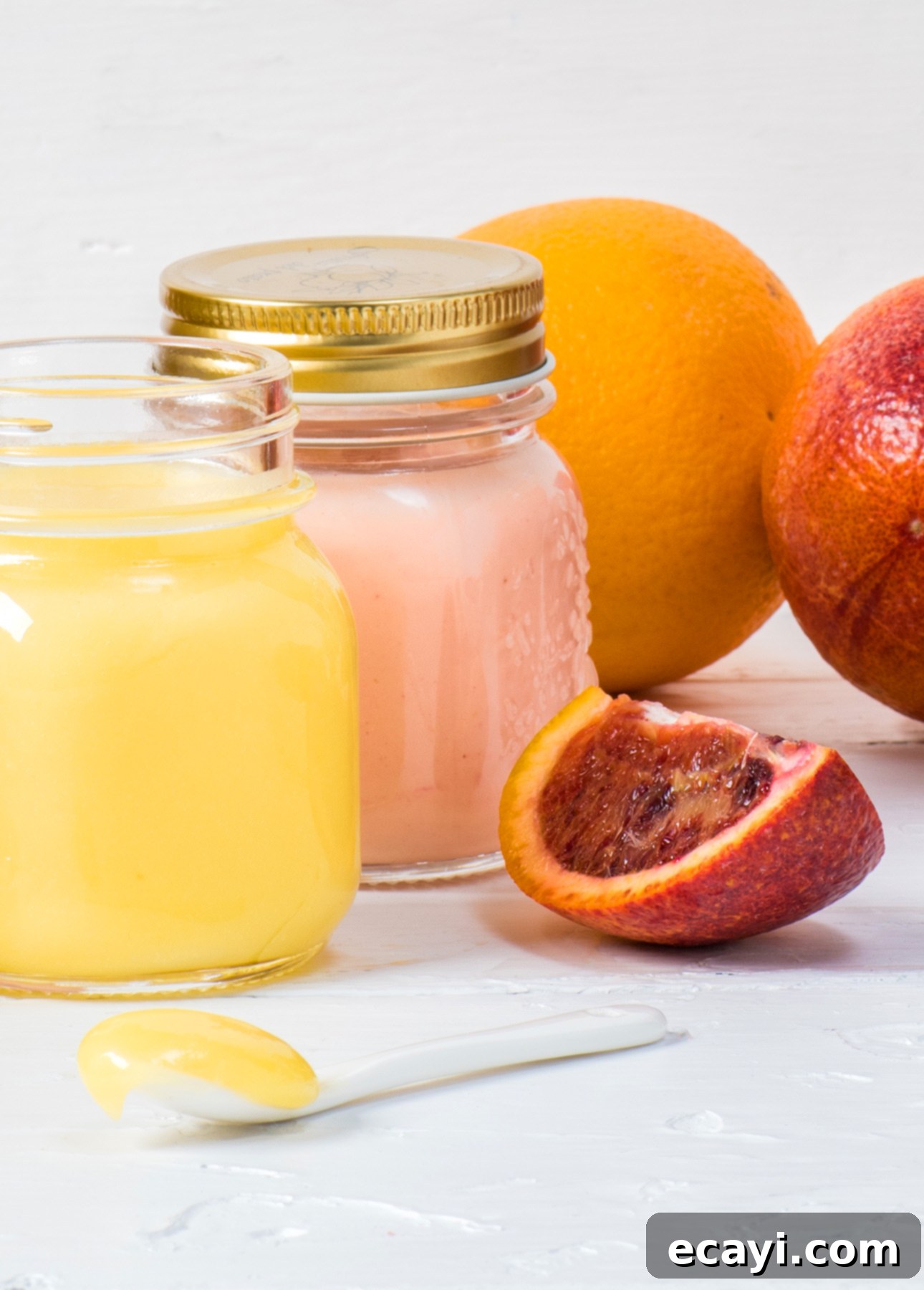
Photo above from my cookbook Simply Citrus.
Approximate Citrus Fruit Juice to Sugar Ratios for Perfect Curds
When you venture beyond traditional lemons to create curds with other citrus varieties in this no-butter recipe, it’s crucial to adjust the sugar content to achieve that ideal sweet-tart balance. Having experimented extensively with nearly every variety of citrus imaginable, I’ve developed these reliable juice-to-sugar ratios to guide you.
The number of citrus fruits suggested below is an estimate designed to help you yield the required amount of juice for the recipe. However, the juiciness of citrus fruits can vary significantly based on their origin, season, and individual fruit characteristics. Therefore, regardless of the specific citrus fruits you choose to use, always ensure that you measure and reach the total amount of 3/4 cup (180 ml) of strained juice required in the recipe. This precise measurement is key to achieving the perfect consistency and flavor balance in your homemade curd.
- Grapefruit, Lemons, Limes, or Key Limes:
- 1 large grapefruit, 4 average lemons, 6 limes, or 18-24 small key limes
- Use: 1/2 cup (100 g) granulated sugar
- These fruits are highly acidic and require a good amount of sugar to temper their sharp tang, balancing it into a delightful pucker.
- Meyer Lemons:
- 6 Meyer lemons
- Use: 1/3 cup (70 g) granulated sugar
- Meyer lemons are naturally sweeter and less acidic than regular lemons, hence they require significantly less sugar to achieve a balanced flavor.
- Oranges (Blood, Cara Cara, or Navel), Mandarins, or Clementines:
- 3 average oranges (any type), or 8 mandarins or clementines
- Use: 1/4 cup (50 g) granulated sugar
- These fruits are considerably sweeter and less tart, needing only a minimal amount of sugar to enhance their natural sweetness without overpowering them.
- Bottled Yuzu Juice:
- 1/2 cup (125 ml) bottled yuzu juice
- Use: 1/2 cup (100 g) granulated sugar
- Yuzu juice is notably tart and aromatic, similar in acidity to lemons and limes, thus requiring a comparable amount of sugar.
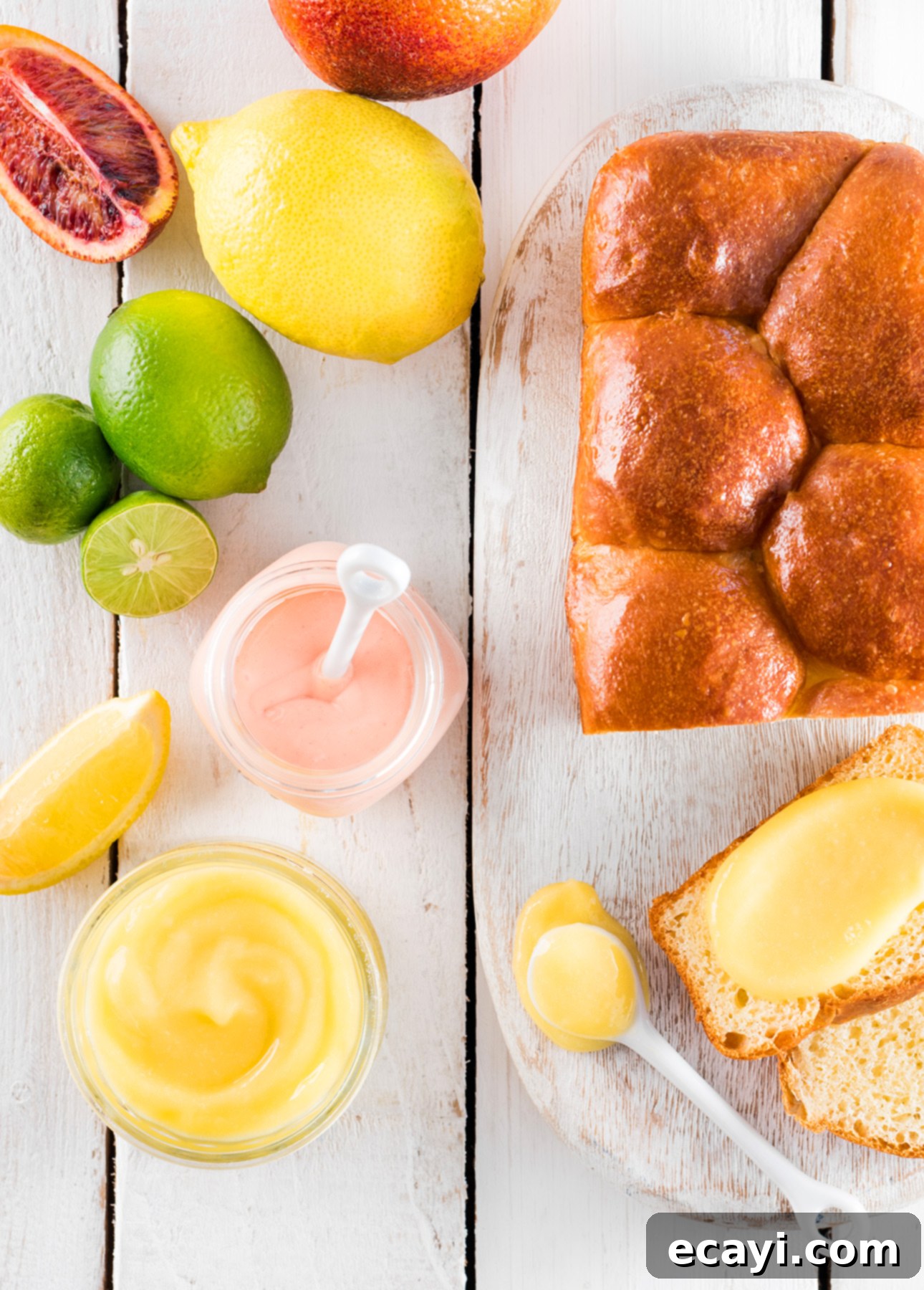
Photo above from my cookbook Simply Citrus.
Delightful Ideas to Use and Serve Your Homemade Lemon Curd
The versatility of homemade lemon curd is truly one of its most appealing qualities. Once you have a jar of this bright, tangy spread in your fridge, the possibilities for enjoying it are virtually endless. From simple breakfasts to elegant desserts, lemon curd adds a sophisticated and refreshing touch to a myriad of dishes:
- As a Luxurious Spread: Elevate your breakfast or tea time by spreading lemon curd generously over warm, flaky scones, toasted artisanal bread, crisp toasts, buttery croissants, fluffy muffins, or even on delicate crumpets. Its vibrant flavor instantly brightens any baked good.
- A Zesty Topping: Transform ordinary desserts and breakfast staples into extraordinary treats. Drizzle spoonfuls of lemon curd over light angel food cake, quick breads, thin crêpes, stacks of fluffy pancakes, or crispy waffles for an invigorating burst of flavor.
- An Exquisite Filling: Lemon curd makes an absolutely divine filling that adds moisture and zing. Pipe it into freshly baked cupcakes, layer it between layered cakes, create stunning tarts and tartlets, fill delicate cream puffs or classic éclairs, or use it to create vibrant thumbprint cookies.
- A Bright Garnish: Add a dollop of lemon curd to enrich and brighten simpler desserts and snacks. Serve it alongside creamy gelato, scoops of vanilla ice cream, plain yogurt, or sprinkle it over granola for a refreshing twist.
And let’s be honest, there’s absolutely nothing wrong with enjoying this no-butter lemon curd quite simply straight out of the jar, by the spoonful! However you choose to serve this wonderfully versatile condiment, you are guaranteed to enjoy its vibrant flavor and smooth texture.
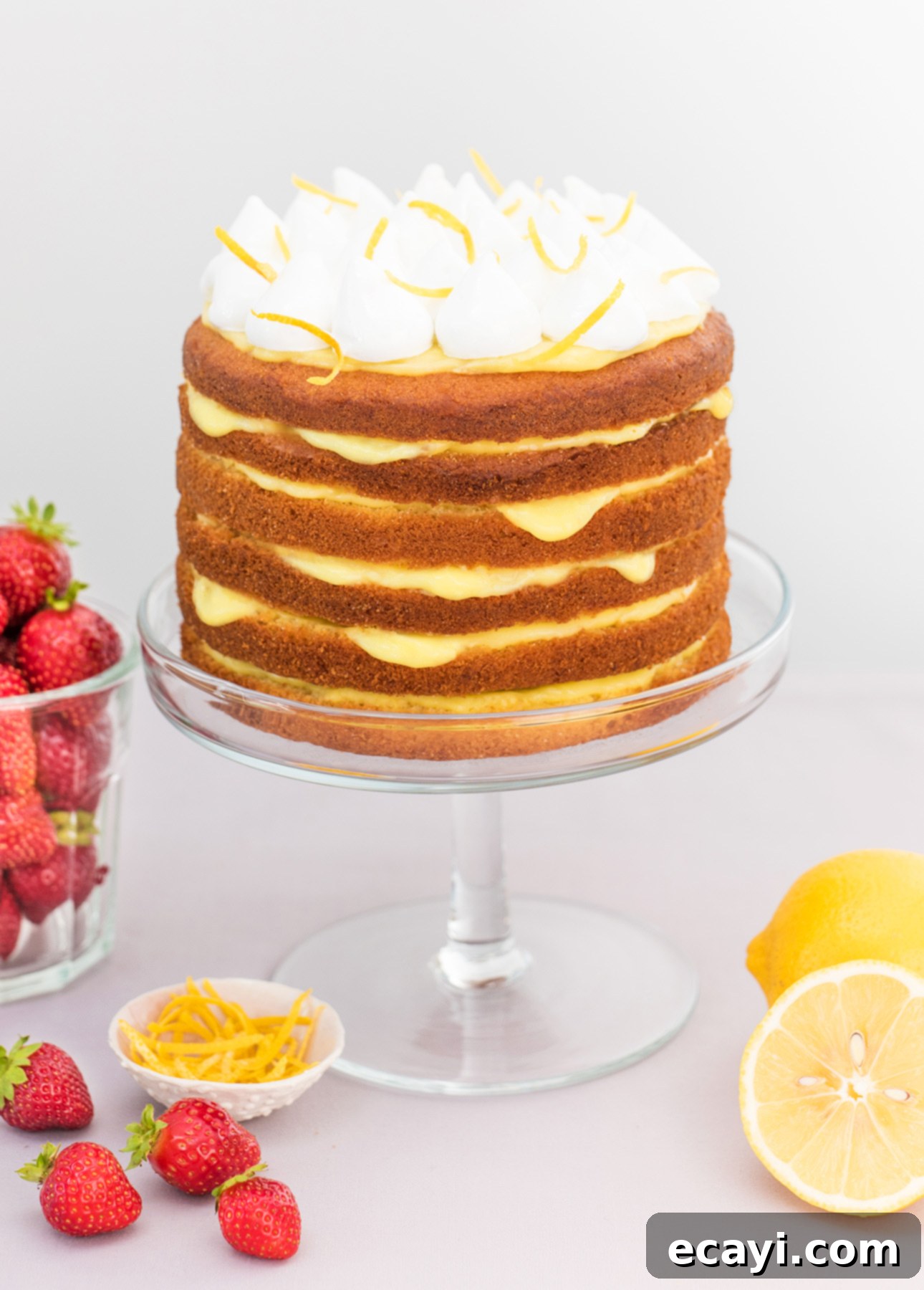
Discover More Zesty Delights with My Citrus Desserts Cookbook!
Do you adore zesty, citrus-centric dessert recipes as much as I do? Then you absolutely must explore my acclaimed Citrus Desserts Cookbook! This vibrant eBook is brimming with colorful, irresistible, and meticulously tested dessert recipes that celebrate the bright flavors of citrus. You’ll find an inspiring collection that includes everything from stunning cakes and elegant tarts to delightful breakfast treats, delicious bars, and spoonable delights, all the way to tempting candies. Each recipe in Citrus Desserts is accompanied by mouthwatering photography, countless clever tips, and innovative variation ideas designed to make the recipes as versatile and adaptable as possible for your kitchen adventures. LEARN MORE and get your copy today!
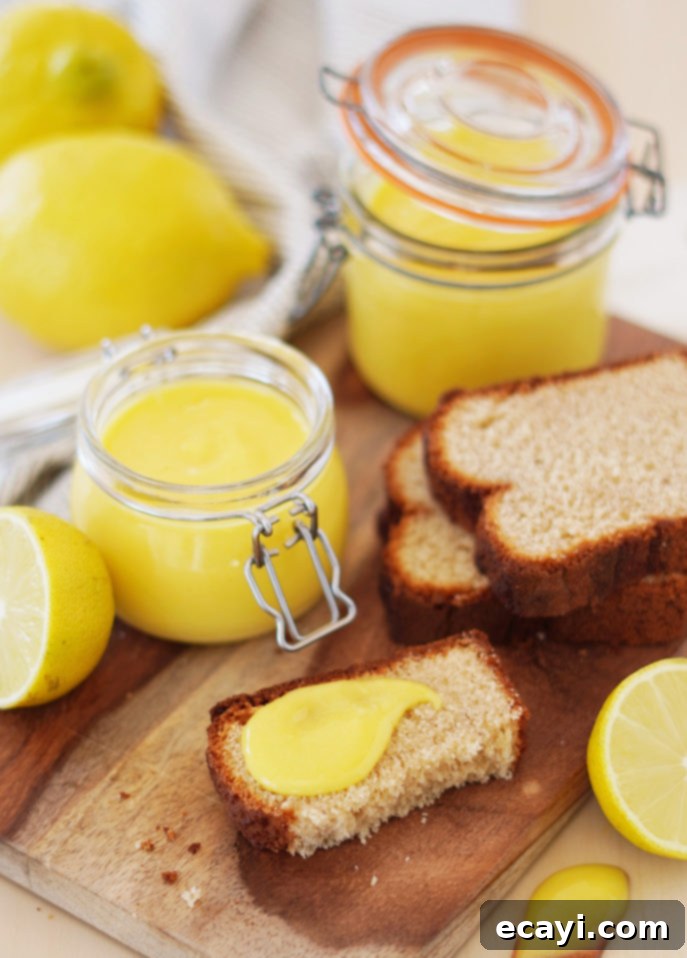
Pin Recipe
No-Butter Lemon Curd Recipe
Ingredients
- 1 tbsp cornstarch
- 1 tbsp water
- ¾ cup freshly squeezed lemon juice (about 4 lemons)
- ½ cup granulated sugar
- 2 large eggs
- ⅓ cup heavy cream (35% m.f., see note, below, for a dairy-free alternative)
Instructions
-
In a small bowl, dissolve the cornstarch in the water. Stir well until completely smooth and set aside.
-
In a saucepan set over medium heat, gently whisk the fresh lemon juice and granulated sugar together. Continue whisking until the sugar is completely dissolved into the lemon juice (it’s not necessary for the mixture to boil). Remove the saucepan from the heat and allow the mixture to cool slightly until it is just warm to the touch. In a separate small bowl, lightly whisk the two large eggs. Gradually and continuously pour the whisked eggs into the warm lemon-sugar syrup in the saucepan, whisking constantly to ensure full incorporation and prevent the eggs from scrambling. Return the saucepan to medium heat. Add the prepared cornstarch mixture to the saucepan and whisk vigorously to incorporate it evenly into the lemon mixture.
-
Continue whisking constantly as the mixture heats and thickens. This continuous motion is crucial to prevent the curd from sticking to the bottom of the pan and burning. Whisk until the mixture achieves a consistency similar to a thick custard or a soft pudding – it should coat the back of a spoon and hold its shape. Once thickened, remove the saucepan from the heat. Whisk in the heavy cream until fully combined and smooth. If you desire a more intensely bright yellow hue, you may add a single drop of yellow food coloring, though I personally prefer to let the lemon curd showcase its beautiful, natural soft yellow shade.
-
STORAGE: Carefully transfer the warm lemon curd into a clean, airtight jar. Refrigerate it until it is completely cold, which will allow it to fully set and achieve its optimal consistency. The lemon curd will keep wonderfully for up to one week in the refrigerator.
-
MAKE IT LACTOSE-FREE OR DAIRY-FREE: For those with dietary restrictions, this recipe can be easily adapted. Simply substitute lactose-free heavy cream or a suitable plant-based cream alternative (such as soy cream or full-fat coconut cream) for the regular heavy cream. Ensure your chosen alternative is a high-fat cream designed for cooking or whipping to maintain the desired richness and texture.
Notes
The quantities of citrus fruits listed below are general estimates intended to yield the approximate 3/4 cup (180 ml) of strained juice needed for this recipe. However, the juiciness of citrus fruits can vary significantly due to factors like their specific variety, growing region, and the season. To ensure the best results and proper consistency for your curd, it is crucial to always measure and confirm you have exactly 3/4 cup (180 ml) of strained juice, regardless of the number of fruits you start with. Adjust the sugar according to the tartness of your chosen citrus.
- For highly acidic fruits like 1 large grapefruit, 4 average lemons, 6 limes, or 18-24 key limes: use 1/2 cup (100 g) granulated sugar.
- For moderately acidic and sweeter fruits like 6 Meyer lemons: use 1/3 cup (70 g) granulated sugar.
- For sweeter, less acidic fruits such as 3 average oranges (blood, Cara Cara, or Navel) or 8 mandarins or clementines: use 1/4 cup (50 g) granulated sugar.
- For tart and aromatic 1/2 cup (125 ml) bottled yuzu juice: use 1/2 cup (100 g) granulated sugar.
Did you make this?
Tell me how you liked it! Leave a comment or take a picture and tag it with @foodnouveau on Instagram.
This site participates in the Amazon Associates Program, an affiliate advertising program designed to provide a means for the site to earn fees by linking to Amazon and affiliated sites.
If you click on an affiliate link, I may earn advertising or referral fees if you purchase through such links at no extra cost to you. This helps me creating new content for the blog–so thank you! Learn more about advertising on this site by reading my Disclosure Policy.
